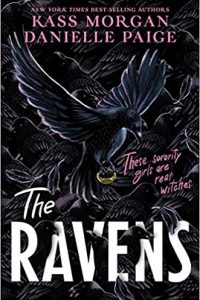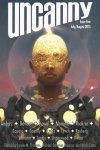Gary K. Wolfe Reviews The Best American Science Fiction and Fantasy 2023 by R.F. Kuang & John Joseph Adams, eds.
 The Best American Science Fiction and Fantasy 2023, R.F. Kuang & John Joseph Adams, eds. (Mariner 978-0-06-331574-7, $18.99, 292pp, tp) October 2023.
The Best American Science Fiction and Fantasy 2023, R.F. Kuang & John Joseph Adams, eds. (Mariner 978-0-06-331574-7, $18.99, 292pp, tp) October 2023.
Now in its ninth year, The Best American Science Fiction and Fantasy 2023 predictably offers a stimulating and eclectic selection of tales, three of which made the Hugo ballot and a few of which are nothing short of brilliant. But it also raises a few questions of purview and definition, even in its very title. In an era which has been celebrating the growing international scope of the field, the emphasis on American fiction seems almost quaint, even though it’s clearly a requirement of the publisher’s multiple series of annual “best American” anthologies (mystery and suspense, food and travel writing, essays, short stories, etc.). In setting up the ground rules for this volume, series editor John Joseph Adams gave himself and guest editor R.F. Kuang considerable leeway, however: Any stories originally published in North America or by writers who “have made North America their home,” providing space for these stories to draw on rich traditions from Korea, Mexico, Canada, Africa, Puerto Rico, and other cultures. Another definitional question comes up when we learn that Adams began by making lists of 40 science fiction and 40 fantasy stories, with Kuang narrowing this field down to ten each. This implies a clear line between the genres, an idea that’s become increasingly problematical in recent decades, and one that’s complicated further by including a few horror stories, presumably as a subset of fantasy.
Finally, there’s the pretty basic question of what a short story is, or at least what we usually expect from the form. While most of the selections are traditionally plotted tales, Kuang shows a literary fascination with more experimental forms, including a story made up of clever improvisations from an issue of National Geographic (Sofia Samatar’s “Readings in the Slantwise Sciences”), another in the form of instructions (“The CRISPR Cookbook: A Guide to Biohacking Your Own Abortion in a Post-Roe World” by MKRNYILGLD), yet another presented as a training dialog for VR (Kim Fu’s amusing “Pre-Simulation Consultation XF007867”), and still another in the form of “Cumulative Ethical Guidelines for Mid-Range Interstellar Storytellers”, Malka Older’s list of instructions which turns into a shrewdly convincing argument for the survival value of storytelling itself. S.L. Huang’s “Murder by Pixel: Crime and Responsibility in the Digital Darkness” is cast in the form of a journalistic article, complete with footnotes and so packed with background exposition that its plot – concerning a rogue AI that may have harassed its victims to suicide and whether a young woman in prison may have developed it – seems little more than an armature for an essay on the risks of AI. Still, it’s a compelling and frightening piece which surely must be one of the first stories to explore the real-world implications of ChatGPT and its cousins. Catherynne M. Valente has often experimented with nonlinear forms, and “The Difference Between Love and Time” is one of her strongest tales yet, hopscotching around the narrator’s shifting lifetime relationship with what she calls the space-time continuum, but ending with a neat sense of a circle completed.
Of the other SF stories, one of the most powerful in the collection is the Nebula Award-winning “Rabbit Test”, by Samantha Mills, which centers around a nightmare future in which women’s bodies are monitored by appallingly intrusive government tech, but which also skips around a bit chronologically, showing how abortifacients have been ubiquitous throughout history, but ending on a note of genuine alarm. Postapocalyptic SF is strongly represented by Susan Palwick’s “Sparrows”, in which a college student braves a ruined and desolate landscape simply to submit her paper on Shakespeare to her professor, as though any completed action is a kind of victory in her world. A couple of stories pointedly allude to SF traditions: Isabel J. Kim’s “Termination Stories for the Cyberpunk Dystopia Protagonist” makes effective use of the neon and rain-slicked streets of films like Blade Runner, while not-too-subtly critiquing the exoticization of Asian culture by naming her protagonist “Cool and Sexy Asian Girl”. Chris Willrich’s “The Odyssey Problem” is a deliberate mash-up of Le Guin’s “The Ones Who Walk Away from Omelas” and classic Star Trek, with mixed results. Though I suspect it’s meant to fall on the fantasy side of the ledger, Theodora Goss’s “Pellargonia: A Letter to the Journal of Imaginary Anthropology” pays homage to Borges in describing a group of high school students who decide to create an imaginary country by flooding the Internet and Wikipedia, until the project takes on an ominous life of its own.
I mentioned that some of the fantasy selections tend toward horror, and it’s a pleasure to see such masters of that form as Stephen Graham Jones and Nathan Ballingrud; Jones with “Men, Women, and Chainsaws”, a neat revenge tale involving a vampire Camaro, and Ballingrud with the oddly moving “Three Mothers Mountain”, about a pair of rural North Carolina brothers who decide to prank some local witches, with not entirely surprising results. Folk horror also figures in Isabel Cañas’s brief “There Are No Monsters on Rancho Buenavista”, which offers a feminist reversal of a Mexican folktale. Of the other fantasy selections, I was most impressed by Alix E. Harrow’s “The Six Deaths of the Saint”, in which the Saint of War repeatedly visits the protagonist in a shrewd exploration of the brutality and oppression inherent in knight’s tales, and Maria Dong’s “In the Beginning of Me, I Was a Bird”, an ambitious and deeply insightful tale which begins with a lonely death and draws on elements of animal fables and even alien invasion tales, as the narrator later passes through the consciousness of a cat, a giraffe, and even a dolphin – all while mysterious seeds fall from the sky, perhaps generating the transformations. I’m not sure that these tales could be said to represent anything about the current state of SF, fantasy, or horror – the best are defiantly sui generis – but they certainly represent an impressive variety of approaches to the fantastic, and to the nature of storytelling itself.
Gary K. Wolfe is Emeritus Professor of Humanities at Roosevelt University and a reviewer for Locus magazine since 1991. His reviews have been collected in Soundings (BSFA Award 2006; Hugo nominee), Bearings (Hugo nominee 2011), and Sightings (2011), and his Evaporating Genres: Essays on Fantastic Literature (Wesleyan) received the Locus Award in 2012. Earlier books include The Known and the Unknown: The Iconography of Science Fiction (Eaton Award, 1981), Harlan Ellison: The Edge of Forever (with Ellen Weil, 2002), and David Lindsay (1982). For the Library of America, he edited American Science Fiction: Nine Classic Novels of the 1950s in 2012, with a similar set for the 1960s forthcoming. He has received the Pilgrim Award from the Science Fiction Research Association, the Distinguished Scholarship Award from the International Association for the Fantastic in the Arts, and a Special World Fantasy Award for criticism. His 24-lecture series How Great Science Fiction Works appeared from The Great Courses in 2016. He has received six Hugo nominations, two for his reviews collections and four for The Coode Street Podcast, which he has co-hosted with Jonathan Strahan for more than 300 episodes. He lives in Chicago.
This review and more like it in the December and January 2023 issue of Locus.
 While you are here, please take a moment to support Locus with a one-time or recurring donation. We rely on reader donations to keep the magazine and site going, and would like to keep the site paywall free, but WE NEED YOUR FINANCIAL SUPPORT to continue quality coverage of the science fiction and fantasy field.
While you are here, please take a moment to support Locus with a one-time or recurring donation. We rely on reader donations to keep the magazine and site going, and would like to keep the site paywall free, but WE NEED YOUR FINANCIAL SUPPORT to continue quality coverage of the science fiction and fantasy field.
©Locus Magazine. Copyrighted material may not be republished without permission of LSFF.







Thanks to Gary K. Wolfe for this timely review of an important annual anthology. The review makes clear the ferment in science fiction and fantasy at short lengths, which has traditionally been a strength of these modes (you see it in the short fiction of H. G. Wells). Reading this review, I recalled what Joyce Carol Oates said in her introduction to “The Best American Short Stories 1979”: “I am not especially disposed to stories with a straight narrative movement, nor do I particularly want or need fiction to have characters, or a clearly evoked setting, or, in fact, much of a ‘point’ at all. I suppose I want simply the sense, which the writer conveys only through the skill of his language, that ‘something’ [italicized] unique is being offered.” It’s no surprise that writers did this in the New Wave era; Joanna Russ’s “Useful Phrases for the Tourist” (Universe 2, 1972) comes to mind. Earlier stories also played with fictional techniques, though. Theodore Sturgeon’s novelette “Bulkhead” (Galaxy Science Fiction, March 1955), is entirely in the second person (“you” point of view). I love the “all bets are off” sensibility of short science fiction and fantasy. I hope it seeps into novel-length work as well.